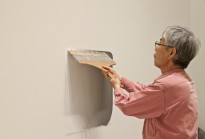A Modest Encounter with Lee Ufan
GALO: How do you perceive the art of today in relation to that of classical artists and that of your own? Is there something that you particularly dislike?
LU: All artists who stand on the fine borders of today are great in their own right. It was relatively uncomplicated, and very often credulous, to create a new current and to become massively prevalent in the art world; whereas today, artistic motives and styles are extremely multifarious, in other words, it is a time of infinite variety. On the contrary, to making a point on artists, it is the sloppy curators who put out tag lines or prematurely determined propositions.
GALO: Many people say that art is universal and holds no boundaries or lines that divide it from country to country. Do you believe this statement to be true? Or do you think that there are certain differences that cannot be understood without at least a basic knowledge of a country’s history and culture?
LU: I have frequented many different geographical locations thus far, where I have also as a result experienced difficulties and hardships. Perhaps with this fact acting as a cause, anything in the nature of nationalism, racialism, and even globalism doesn’t interest me at all. As historic thinkers like Kant would affirm, art has to, first of all, resolve through the self. At the same time, considering my background of youth, my memories from those days have gotten into [my] DNA. One should however note the risk of dogmatism, which can easily come about and be dangerous, if one attempts to rationalize it.
GALO: In past interviews, you mentioned that you do not wish to follow the rules of the modern art world today because you do not want to be constrained by them; you want to be free. Could you elaborate on this?
LU: Even as one criticizes the modern, it is harbored and lurks everywhere in my environment. This means that critique toward Modernism redirects itself onto the person criticizing, but at the same time it is a manifestation of one’s own desire for the unknown of the future. If Modernity gives us the world of the internal via Ego, our contemporaneity proposes the world of the external through the relationship between the Self and the Other.
GALO: You have described your art as “the art of encounter.” Please explain what you mean by this.
LU: If a work of art is to be seen and determined as a solidified meaning, it is simply not fun at all. The circulation of meaning should be allowed to flow in different vectors, like in a room with its two windows wide open on each side. Similarly in work-viewer relationship, there must be a sense of vibrating resonance of encounter. Encounter then, is a sort of shaking, as well as [a] new birth.
GALO: Is there one museum, gallery or country that you have not yet exhibited at, but wish you could? If yes, which one and why?
LU: There is plenty. But oddly enough, something tells me that I am longing to open an exhibition [on] some anonymous planet. By this, I want spectators to respond to my exhibitions, so that they see a glimpse of the jargon of the universe.
GALO: What are your artistic plans for the near future?
LU: My next goal is to sublimate my present works to a higher platform of dimension.
GALO: Lastly, what piece of advice would you give to those who are just starting out and trying to make a difference in the art world today?
LU: The grand tendency of today’s art world is to contradict the idea of ‘body’ and ‘time.’ My interest is in looking at how it will develop.
The Lee Ufan: Marking Infinity exhibition is on view at the Guggenheim Museum in New York until September 28, 2011.











